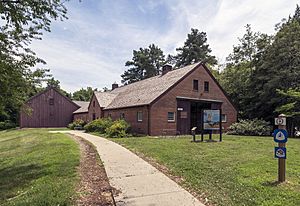- This page was last modified on 17 October 2025, at 10:18. Suggest an edit.
Jefferson Patterson Park & Museum facts for kids
Jefferson Patterson Park & Museum (JPPM) is a super cool place in St. Leonard, Calvert County, Maryland! It's a huge state park and museum, covering 560 acres right along the Patuxent River. Imagine exploring a place with over 9,000 years of human history!
This amazing park was given to the state of Maryland in 1983 by Mary Marvin Patterson. She wanted to honor her husband, Jefferson Patterson, who was a U.S. diplomat. Many of the park's buildings were designed by Gertrude Sawyer starting in the 1930s. Some of the beautiful outdoor areas were planned by Rose Greely and Cary Millholland Parker.
JPPM has more than 70 special spots where archaeologists have found clues about people who lived there long ago. Scientists are still digging and learning new things about the past.
The park is a great place for outdoor fun! You can find hiking and biking trails, and even a spot to launch your canoe or kayak. There's a visitor center with interesting exhibits and a gift shop. You can also explore an exhibit barn, a pavilion for events, and a recreated Woodland Indian village. There's even a historic house to see! JPPM hosts several annual events, educational programs, and fun summer camps. The best part? Admission is free!
The visitor center used to be a cattle barn. Now, it has displays about the Patterson family and the exciting science of archaeology. You can learn about the important work being done right there at the park. The Exhibit Barn features a special display about the War of 1812 and shows off old farm equipment.
The Woodland Village was built in 2007. It helped celebrate the 400th anniversary of John Smith's journey exploring the Chesapeake Bay. This village helps us imagine what life was like when John Smith visited the Native people living along the Patuxent River. It has four wigwams, a central fire pit, and a garden outside the fence. In the garden, you can see the types of plants Native people grew.
Exploring Archaeology at JPPM
JPPM is also home to the Maryland Archaeological Conservation Laboratory, often called the MAC Lab. This lab is a huge storage place for almost 10 million artifacts! These are items found from archaeological digs on land and underwater all over Maryland.
What is the MAC Lab?
The MAC Lab is like a central library for archaeological finds. It collects and keeps artifacts from projects done by state and federal groups. These collections are available for anyone who wants to study them. This includes students, scholars, museum curators, and teachers. They can use these items for research, learning, and creating new exhibits.
Patterson's Archaeological District
A special area called Patterson's Archeological District is part of the park's lands. This district is recognized for its important archaeological sites. It helps protect the history found there.

